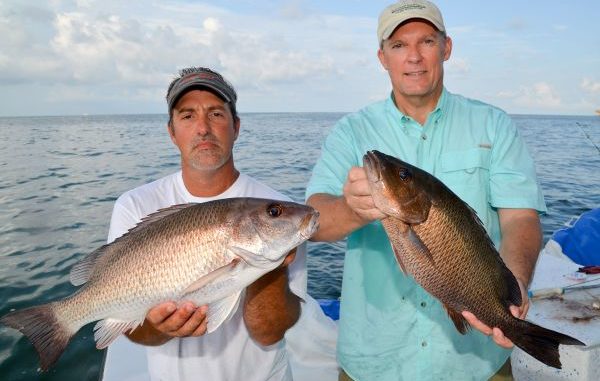
Kenny Heikamp is built like a 5-foot, 7-inch coiled steel spring. He moves about his 32-foot Twin Vee catamaran with latent, ready to unleash energy. His chin has a determined set to it and his dark eyes burn intensely, like hot embers. I would hate to be a fish, knowing that he was after me.
The 43-year-old has operated Bent Rod Offshore Charters for 10 years, but his fishing roots go much deeper. When he was 16 and again when he was 17 years old, he worked whole summers on a commercial snapper boat out of Fourchon operated by Joey Toups. The third summer he spent commercial king mackerel fishing, also with Toups.
The offshore bug bit him bad. “It’s just you and Mother Nature out there,” he explained. You got to have your stuff together. The gulf will find your weaknesses. And the idea of dropping a line and not knowing what you are going to bring up turned me into an offshore fisherman.”
At 19, he became part of the Toups, Toups and Toups competitive king mackerel team in the Southern Kingfish Association (SKA). Joey Toups ran the team. His brother Anthony Toups funded them. The third Toups, one unrelated to the first two, was Raymond Toups, whose day job was being the Executive Chef at the Omni Royal Orleans Rib Room in the New Orleans French Quarter.
Heikamp fished with them in the SKA for 9 years while he worked for a refrigeration company. “It was a good experience,” he said. “It opened my eyes about how serious people can get about money and fishing.”
Never one to leave a moment free without fishing, Heikamp, when he wasn’t working refrigeration or kingfishing, worked as a deck hand on the Toups’ charter boat. Red snappers, before regulators choked the life out of the fishery, were a big deal in those days. They also fished for mangrove snappers, amberjacks, mahi, and some tuna.
After parting with the Toups, he bought three boats, a bay boat and two offshore boats for fishing with family and friends. While he owned this third boat, a Scarab, he bought his federal charter fishing permits in 2000.
He began chartering in 2004. When asked about the 4 year gap between getting his permits and beginning to charter, he grinned. “I spent that time learning to be good.”
Heikamp did some interesting stuff during this “learning period.” He often slipped on a mask, flippers and snorkel and dove overboard while his friends on board fished for mangrove snappers at an offshore platform.
He watched the fish intently. “Mangroves would swim up to a bait and then swim away,” he said with a note of wonder still in his voice. “I learned that fish have a lot of patience. If it doesn’t look right, they don’t have to eat it.
“Those baits didn’t seem to be working naturally, so I began to experiment. I said ‘let’s try fishing without a weight.’ Then I went to smaller hooks and then fluorocarbon line. I began to use better reels with smoother drags and stiffer rods to get the fish out of the rig.”
He also learned to respect the intelligence, eyesight, and adaptability of mangrove snappers. “When a fish broke off, it went straight to the furthest corner of the rig and it went deeper, sometimes out of sight. A lot of the other mangroves would follow it. Not all of them, but if there were 50 fish there, that one fish would take a quarter of them with it.
“It takes 15 minutes for things to get back to normal — unless you break off a bunch of fish. That can kill the bite. The end result for many fishermen is four or five fish a trip. They get frustrated and think we (guides) are lying to them.
“You know what else I learned from jumping in the water,” he smirked? “There’s a whole lot more fish down there than I expected.”
